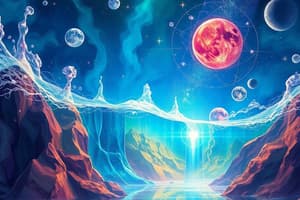Podcast
Questions and Answers
What happens to the forces between particles when a solid melts?
What happens to the forces between particles when a solid melts?
- The forces remain unchanged between the particles.
- The forces completely disappear between the particles.
- The forces weaken, allowing particles to move more freely. (correct)
- The forces strengthen between the particles.
At what temperature does water freeze and melt?
At what temperature does water freeze and melt?
- 212 ºC
- 0 ºC (correct)
- 32 ºC
- 100 ºC
What is the key difference between boiling and evaporation?
What is the key difference between boiling and evaporation?
- Boiling occurs only at the surface of the liquid.
- Boiling involves bubbles of gas forming within the liquid. (correct)
- Evaporation occurs at any temperature, while boiling occurs at a specific temperature.
- Boiling requires a specific heat input while evaporation does not.
Which of the following statements about freezing is true?
Which of the following statements about freezing is true?
What determines the amount of energy needed to change the state from solid to liquid?
What determines the amount of energy needed to change the state from solid to liquid?
What is required for evaporation to occur?
What is required for evaporation to occur?
Which statement accurately describes condensation?
Which statement accurately describes condensation?
Which of the following solids is known to undergo sublimation?
Which of the following solids is known to undergo sublimation?
What happens to the energy of particles during state changes?
What happens to the energy of particles during state changes?
What is desublimation?
What is desublimation?
What happens to the color of potassium manganate (VII) when it is diluted in water?
What happens to the color of potassium manganate (VII) when it is diluted in water?
What is the definition of a solvent?
What is the definition of a solvent?
Which of the following describes a saturated solution?
Which of the following describes a saturated solution?
Which term describes a substance that will dissolve in a liquid?
Which term describes a substance that will dissolve in a liquid?
What can be concluded from observing the gradual fading of color when potassium manganate (VII) is diluted?
What can be concluded from observing the gradual fading of color when potassium manganate (VII) is diluted?
What is an example of a solute?
What is an example of a solute?
Which statement is true regarding an insoluble substance?
Which statement is true regarding an insoluble substance?
What is the result of diluting a solution several times?
What is the result of diluting a solution several times?
What supports the theory that all matter is made up of tiny, moving particles?
What supports the theory that all matter is made up of tiny, moving particles?
Why does the diffusion of bromine gas occur quickly between two jars?
Why does the diffusion of bromine gas occur quickly between two jars?
What is observed when potassium manganate(VII) is dissolved in water?
What is observed when potassium manganate(VII) is dissolved in water?
What is the reason that diffusion in liquids occurs more slowly than in gases?
What is the reason that diffusion in liquids occurs more slowly than in gases?
Which of the following describes how diffusion occurs in gases?
Which of the following describes how diffusion occurs in gases?
What happens to the intensity of color when more potassium manganate(VII) crystals are added to water?
What happens to the intensity of color when more potassium manganate(VII) crystals are added to water?
In dilution, what is generally expected to happen to the concentration of a solution?
In dilution, what is generally expected to happen to the concentration of a solution?
During diffusion, what is primarily responsible for the mixing of particles?
During diffusion, what is primarily responsible for the mixing of particles?
What is solubility a measurement of?
What is solubility a measurement of?
Which of the following factors affects the solubility of gases?
Which of the following factors affects the solubility of gases?
How is solubility typically expressed?
How is solubility typically expressed?
What happens to the solubility of most solids as temperature increases?
What happens to the solubility of most solids as temperature increases?
What is the maximum mass of potassium nitrate that can dissolve in 20 g of water at 50 °C based on the solubility of 68 g per 100 g of water?
What is the maximum mass of potassium nitrate that can dissolve in 20 g of water at 50 °C based on the solubility of 68 g per 100 g of water?
When cooling a solution from 90 °C to 40 °C, what happens to the solubility of lead(II) nitrate?
When cooling a solution from 90 °C to 40 °C, what happens to the solubility of lead(II) nitrate?
How does increased pressure generally affect the solubility of gases?
How does increased pressure generally affect the solubility of gases?
Which salt's solubility shows little change with temperature?
Which salt's solubility shows little change with temperature?
What is the total mass of lead(II) nitrate crystallised from 200 cm3 of solution?
What is the total mass of lead(II) nitrate crystallised from 200 cm3 of solution?
Which of the following best describes how solubility of solids and gases changes with temperature?
Which of the following best describes how solubility of solids and gases changes with temperature?
What is the first step in the method to investigate the solubility of a solid at different temperatures?
What is the first step in the method to investigate the solubility of a solid at different temperatures?
During the practical, what should be noted when crystals first appear?
During the practical, what should be noted when crystals first appear?
How much distilled water is initially measured for the experiment?
How much distilled water is initially measured for the experiment?
What is done after the boiling tube is placed into the ice bath?
What is done after the boiling tube is placed into the ice bath?
Which chemical is specifically weighed out for the practical investigation?
Which chemical is specifically weighed out for the practical investigation?
What occurs after adding 1 cm3 of distilled water to the boiling tube during the method?
What occurs after adding 1 cm3 of distilled water to the boiling tube during the method?
Flashcards
Melting Point
Melting Point
The temperature at which a solid changes into a liquid. It is also the temperature at which a liquid changes into a solid.
Boiling
Boiling
The change of state from a liquid to a gas. It occurs when heat energy is absorbed by the liquid, causing the particles to move faster and escape as gas.
Evaporation
Evaporation
The change of state from a liquid to a gas. It occurs at the surface of a liquid when the liquid particles gain enough energy to escape.
Freezing
Freezing
Signup and view all the flashcards
Forces Between Particles and State Changes
Forces Between Particles and State Changes
Signup and view all the flashcards
Condensation
Condensation
Signup and view all the flashcards
Sublimation
Sublimation
Signup and view all the flashcards
Desublimation or Deposition
Desublimation or Deposition
Signup and view all the flashcards
State Changes and Energy
State Changes and Energy
Signup and view all the flashcards
Solvent
Solvent
Signup and view all the flashcards
Solute
Solute
Signup and view all the flashcards
Solution
Solution
Signup and view all the flashcards
Saturated Solution
Saturated Solution
Signup and view all the flashcards
Soluble
Soluble
Signup and view all the flashcards
Insoluble
Insoluble
Signup and view all the flashcards
Diffusion
Diffusion
Signup and view all the flashcards
Diffusion in Gases
Diffusion in Gases
Signup and view all the flashcards
Bromine Gas Diffusion
Bromine Gas Diffusion
Signup and view all the flashcards
Diffusion in Liquids
Diffusion in Liquids
Signup and view all the flashcards
Potassium Manganate(VII) Diffusion
Potassium Manganate(VII) Diffusion
Signup and view all the flashcards
Diffusion Speed in Liquids
Diffusion Speed in Liquids
Signup and view all the flashcards
Cause of Diffusion
Cause of Diffusion
Signup and view all the flashcards
Solubility
Solubility
Signup and view all the flashcards
Concentration
Concentration
Signup and view all the flashcards
Solubility Curve
Solubility Curve
Signup and view all the flashcards
Dissolving
Dissolving
Signup and view all the flashcards
Crystallization
Crystallization
Signup and view all the flashcards
Heating a Solution
Heating a Solution
Signup and view all the flashcards
Cooling a Solution
Cooling a Solution
Signup and view all the flashcards
Crystallization Temperature
Crystallization Temperature
Signup and view all the flashcards
Study Notes
States of Matter
- Matter exists in three states: solids, liquids, and gases.
- Substances can exist in all three states, depending on temperature and pressure.
- State changes occur at specific points: melting point (solid to liquid), boiling point (liquid to gas).
- Melting and freezing occur at the same temperature.
- Boiling and condensing occur at the same temperature.
- Individual atoms are different from bulk matter.
- Matter can be represented as small solid spheres.
- Solids have a regular arrangement of particles, vibrating about fixed positions, very close together.
- Liquids have a random arrangement of particles, moving around each other, close together.
- Gases have randomly arranged particles, moving quickly in all directions, far apart.
Changing States of Matter
- The amount of energy needed for a state change depends on the forces between particles.
- Stronger forces mean higher melting and boiling points.
- Changing states is a physical change; the particles remain the same, only the forces between them change.
- Melting is when a solid becomes a liquid, absorbing heat and transforming it into kinetic energy.
- Boiling is when a liquid becomes a gas, absorbing heat and transforming it into kinetic energy, usually occurring at a specific temperature, known as the boiling point.
- Freezing is when a liquid becomes a solid, releasing heat. It occurs at the same temperature as melting.
- Evaporation occurs at temperatures below the boiling point, only at the surface, and depends on the surface area and temperature.
- Condensation is the conversion of a gas to a liquid, releasing energy.
- Sublimation is when a solid changes directly into a gas, without becoming a liquid. Deposition is the opposite process of sublimation.
Diffusion and Dilution
- Diffusion is the spreading of particles from a high to low concentration.
- Dilution involves adding a solvent to reduce the concentration of the substance.
- Diffusion experiments show that matter is made of tiny particles in constant, random motion.
- In gases, particles move randomly with large gaps between them, allowing for mixing.
- In liquids, particles move randomly, but there are smaller gaps than in gases, making diffusion slower.
- The speed of diffusion depends on the temperature; higher temperatures mean faster movement of particles.
Solubility
- Solubility is the amount of a substance that will dissolve in a specific volume of a liquid at a particular temperature.
- The solubility of a solid typically increases as temperature increases.
- The solubility of a gas typically decreases as temperature increases.
- The solubility of a gas increases as pressure increases.
- Solubility can be expressed in grams per 100 grams of solvent.
- Solubility curves show the relationship between solubility and temperature for a substance.
- Saturated solutions hold the maximum amount of solute possible at a given temperature.
Practical: Investigating Solubility
- Students can investigate how the solubility of a substance varies with temperature.
- Specific instructions (method) are provided for conducting the experiment and recording results.
- The experiment involves measuring the solubility of a solid (e.g., ammonium chloride) in water at different temperatures.
- Results typically are presented in tables showing the mass of the solute needed for saturation at each temperature.
- Plotting a solubility curve for results helps to visualize how solubility changes with temperature.
Studying That Suits You
Use AI to generate personalized quizzes and flashcards to suit your learning preferences.




